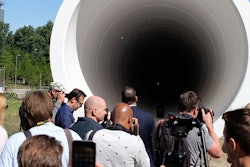Microsoft Researches AR/VR Glasses
Seemingly following in the footsteps of Google Glass, Microsoft is reportedly working on a prototype pair of eyeglasses that would allow a wearer to see a full-color, see-through holographic display that adds augmented reality to the real world. While this might sound like another Microsoft device, the Hololens, this new research hopes to build the technology into a normal pair of glasses.
The new glasses fit an 80 degree field of view to allow the user to see the entire scene at once in a realistic, immersive way. Currently, the prototype only includes a monoscopic display with external essential electronics, but the company will have to clear huge hurdles in order to create a stereoscopic display and internalized driving electronics that achieve the company’s goal of being a truly wearable device.
The Microsoft prototype also improves on current focus control methods since holograms are able to respond to focal depth on a pixel-by-pixel basis. Combined with advanced eye tracking, this focus control will allow a scene to render the sharpest where the user is looking.
While Microsoft is only conducting research at this point, near-eye holographic displays for VR and AR will become a major computing platform in the future, according to many industry experts.
SO, WHAT DO YOU THINK?
Does this research move us closer to a VR/AR world? Do you think this technology will put a nail in the coffin for desktop computers? Tell us what you think by leaving your comments below.
Nimble Robots
If there is one advantage humans have over robots, it is our ability to pick up awkwardly shaped objects.
But, not for long. New advancements out of UC Berkeley’s AUTOLAB now allow robots to pick up unfamiliar, real-world objects with a 99-percent success rate.
To achieve this, researchers created a database full of 3D objects — containing more than 6 million data points — which the new nimble robot accesses with a neural network to learn the best grasp to pick up irregular objects. The robot, named DexNet 2.0, will even poke at the object to move it into a position that is easier to grab.
The DexNet 2.0 was tested using dozens of objects it hadn’t seen before and only failed once. It also takes the robot less than a second to decide which grip to use.
Researchers say the technology could be coming to the industry soon and the high grasping success rate could be a game-changer for manufacturing and the supply chain.
SO, WHAT DO YOU THINK?
How do you see robots similar to DexNet 2.0 being utilized in the manufacturing world? Let us know what you think in the comments below.






















